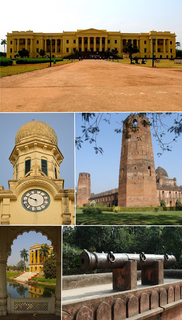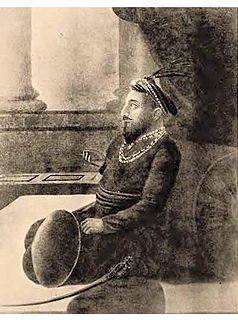
A zamindar in the Indian subcontinent was an autonomous or semiautonomous ruler of a province who were originally known as bhumipatis. They accepted the suzerainty of the Emperor of Hindustan and were converted into zamindars by the Mughals and later the British. The term means land owner in Persian. Typically hereditary, zamindars held enormous tracts of land and control over their peasants, from whom they reserved the right to collect tax on behalf of imperial courts or for military purposes.

Murshidabad is a historical city in the Indian state of West Bengal. It is located on the eastern bank of the Bhagirathi River, a distributary of the Ganges. It forms part of the Murshidabad district.

Natore district is a district of Rajshahi Division located in northern Bangladesh. It borders the metropolitan city of Rajshahi, and used to be part of Rajshahi district.

The Nawab of Bengal was the hereditary ruler of Bengal Subah in Mughal India. In the early 18th-century, the Nawab of Bengal was the de facto independent ruler of the three regions of Bengal, Bihar, and Orissa which constitute the modern-day sovereign country of Bangladesh and the Indian states of West Bengal, Bihar and Orissa. They are often referred to as the Nawab of Bengal, Bihar and Orissa. The Nawabs were based in Murshidabad which was centrally located within Bengal, Bihar, and Odisha. Their chief, a former prime minister, became the first Nawab. The Nawabs continued to issue coins in the name of the Mughal Emperor, but for all practical purposes, the Nawabs governed as independent monarchs. Bengal continued to contribute the largest share of funds to the imperial treasury in Delhi. The Nawabs, backed by bankers such as the Jagat Seth, became the financial backbone of the Mughal court. During the 18th century, the Nawabs of Bengal were among the wealthiest rulers in the world.
Rani Bhabani (1716–1795) was a Hindu zamindar, also known as the 'Queen of Natore' during the British colonial era in what is now of Rajshahi, Bangladesh. She was married to Maharaja Ramkanta Moitra (Ray), 'Zamindar' of Natore estate. Rajshahi Raj or Natore estate was a large zamindari which occupied a vast position of Bengal. The Natore estate had an area of nearly 34,000 square kilometres (13,000 sq mi) and included not only much of North Bengal but also large parts of the areas later comprising the administrative districts of Murshidabad, Nadia, Jessore, Birbhum and Burdwan. After the death of her husband, Rani Bhabani of Natore Rajbari, expanded both the estate and the palace.

Sahibzada Mīrzā Mu'hammad Jalāl ud-Dīn Mridha Sahib, better known as Jalaluddin Mirza (1898–1975), was a Bengali Indian aristocrat in the erstwhile British Empire who served as the fifth and last hereditary Zamindar of Natore from the House of Singra and Natore before it was abolished in 1951.

Bhawal Estate was the second largest zamindari in Bengal until it was abolished according to East Bengal State Acquisition and Tenancy Act of 1950.

The Uttara Ganabhaban is an 18th-century (1734) royal palace also known as Dighapatia Palace as it was formerly the seat of the Dighapatia Raj, an aristocratic landed estate in the East Bengal of India. It is a fine example of a jomidar bari. It was built by Raja Doyaram who was the Dewan (minister) of Rani Bhavanee. It has a round clock on its front gate with a large bell and a clock room. The clock was imported from Italy. It also has a beautiful garden full of various foreign trees and Italian marble stone statues of women. It is located near Natore town in North Bengal. It serves as the principal residence of the Bangladeshi Prime Minister in the northern part of the country. It has been used as a ceremonial site for receiving foreign ambassadors.
Singra is an upazila of Natore District in the Division of Rajshahi, Bangladesh.
The Singranatore family is the consanguineous name given to a noble family in Rajshahi of landed aristocracy in erstwhile East Bengal and West Bengal that were prominent in the nineteenth century till the fall of the monarchy in India by Royal Assent in 1947 and subsequently abolished by the newly formed democratic Government of East Pakistan in 1950 by the State Acquisition Act.

Murshid Quli Khan, also known as Mohammad Hadi and born as Surya Narayan Mishra, was the first Nawab of Bengal, serving from 1717 to 1727.

The Puthia Temple Complex consists of a cluster of notable old Hindu temples in Puthia Upazila, Rajshahi District, Bangladesh. Located 23 km to the east of Rajshahi city, it has the largest number of historic temples in Bangladesh. The temples were built by Hindu Zamindars Rajas of the Puthia Raj family who were noted philanthropists of Rajshahi. The temples have been built in terracotta in a variety of styles combining the typical Jor-bangla architecture with other influences. The Rajbari or Palace of the Raja of Puthia and the Dol Mancha are part of the complex. The temples are laid out around a lake with a sprawling lawn.

Natore Rajbari was a prominent royal palace in Natore, Bangladesh. It was the residence and seat of the Rajshahi Raj family of zamindars. The famous queen Rani Bhabani lived here and after the death of her husband, expanded both the estate and the palace.

Raja Sitaram Ray (1658–1714) was an autonomous king, a vassal to the Mughal Empire, who revolted against the empire and established a short-lived sovereign Hindu dominion in Bengal region of the Indian subcontinent.

Dighapatia Raj was a zamindari in present-day Rajshahi, which was ruled by this dynasty of 7 generations of Rajas from early 18th century till the mid-20th century; when the democratic government took power after the end of the British Monarchy's rule in India, in 1950, the East Pakistan government abolished aristocracies and the zamindari system in present-day Bangladesh. The family was seated at the Dighapatia Palace.

Rajshahi Raj was a large zamindari which occupied a vast position of Bengal. It was the richest and second largest zamindari with an area of about 33,670 km2, after the Burdwan Raj. The Royal Family of Rajshahi used the title Ray/Rai and their surname was Maitra. The zamindari came into being during the early part of the 18th century when Nawab Murshid Quli Khan was the Dewan/Subahdar of Bengal (1704–1727).

The East Bengal State Acquisition and Tenancy Act of 1950 was a law passed by the newly formed democratic Government of East Bengal in the Dominion of Pakistan. The bill was drafted on 31 March 1948 during the early years of Pakistan and passed on 16 May 1951. Before passage of the legislature, landed revenue laws of Bengal consisted of the Permanent Settlement Regulations of 1793 and the Bengal Tenancy Act of 1885.

The Zamindars of Bengal were zamindars of the Bengal region of the Indian subcontinent. They governed an ancient system of land ownership.
Mirza Mu'hammad Zahir ud-Din Shah (1855–1899) known as Mirza Zahir Shah was a Mughal descendant and an Indian nobleman in the erstwhile British Empire who was the first Zamindar of Natore and patriarch of the House of Singra and Natore.

The zamindars of Mahipur were a Bengali aristocratic family of feudal landowners. The zamindari estate encompassed the Chakla of Qazirhat under the Cooch Behar State since the Mughal period. Although their aristocratic status was lost with the East Bengal State Acquisition and Tenancy Act of 1950, the Mahipur estate remains an important part of the history of Rangpur and belongs to one of the eighteen ancient zamindar families of Rangpur. The zamindari palace was lost as a result of flooding from the Teesta River, although the mosque, cemetery, polished reservoir and large draw-well can still be seen today.





















